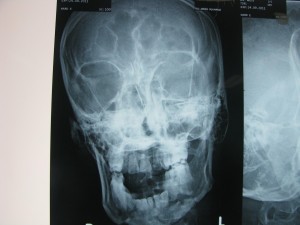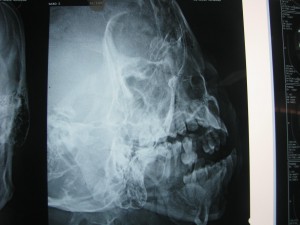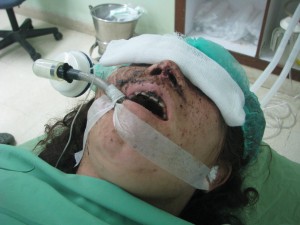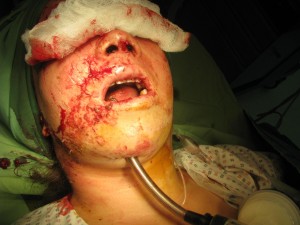Ayesha Mohiuddin, DA*, Ahsan Shabir*, Riaz Ahmed Khan, MCPS, FCPS**,
Zubair Durrani, BDS, MBchB, FRCS***
*TMO (FCPS Anaesthesiology),
**Associate Professor & Head Dept. of Anaesthesia and Intensive Care,
***Consultant Faciomaxillary and Plastic Surgeon
Rehman Medical Institute, Peshawar Pakistan
Correspondence: Col (R) Riaz Ahmed Khan, Head, Department of Anaesthesia, Pain and Intensive Care, Rehman Medical Institute, Hayatabad, Peshawar (Pakistan); E-mail: riaz_kmc75@yahoo.com
ABSTRACT
Surgical repair of complex maxillofacial trauma presents a challenge to the surgeon and anesthesiologist. Where intubations via oral and nasal route cannot be performed, sub-mental route of endotracheal intubation is a very useful alternative. It obviates the need for tracheostomy and its related complications. We are presenting a case where we avoided tracheostomy in a patient with multiple maxillofacial fractures and opted for the sub-mental endotracheal intubation technique.
Keywords: Maxillofacial trauma; Sub-mental intubation.
Citation: Mohiuddin A, Shabir A, Khan RA, Durrani Z. Submental intubation in extensive maxillofacial trauma. Anaesth Pain & Intensive Care;15(3):182-184.
INTRODUCTION
Maxillofacial surgical procedures for pan-facial trauma poses a unique set of problems both to surgeon and anaesthetist. Achieving dental occlusion frequently during these procedures is one of the fundamental aims of most of maxillo-facial procedures. Dental occlusion during these procedures rules out use of traditional oro-tracheal intubation.¹ Naso-tracheal intubation is contraindicated in nasal fractures, fracture of cribriform plate of ethmoid, mid and pan-facial fractures where surgical reconstruction of fractures of the naso-orbital-ethmoidal complex is required.² In these situations the standard solution is to perform elective tracheostomy before surgery, which in turn is associated with many inherent complications. An alternative method first devised by Sir Hernandez Altemir in 1986 ³, is to introduce an endotracheal tube via a sub-mental incision. Sub-mental intubation is a safe and convenient alternative airway provision as a substitute for naso-tracheal intubation or tracheostomy. The technique consists of diverting the proximal end of an oro-tracheal tube through the floor of the mouth and sub-mental region. This technique provides an unconventional method for maintaining airway with minimal complications and greater margin of safety.
CASE REPORT
A 30 yr old Afghan lady met a road traffic accident sustaining multiple mandibular and maxillofacial injuries. She presented to us in accident and emergency department on 4th post RTA day.
At the time of presentation, patient was conscious with a Glasgow coma score of 15/15. On examination she had facial swelling with multiple lacerations and a brief history of unconsciousness at the time of accident. She was having fractures of bilateral parasymphysis of mandible, right maxilla, right zygomatic bone, naso-ethmoidal bone, left 1st rib, right clavicle, and undisplaced fracture of body of C2 with left 2nd metacarpal dislocation seen on X-rays and later confirmed by CT scan (Fig 1 & 2).
Fig 1 & 2: X-ray films of the skull
In pre-anesthesia evaluation she gave history of loss of consciousness for a brief period of time probably as a result of brain concussion. She had no other significant medical or surgical illness. She was medium built and well-nourished young woman with stable vitals and good cardio-respiratory reserves. Airway assessment revealed fragmented fracture of mandible with restricted mouth opening. Laboratory investigations were within normal range.
Case was discussed with maxillofacial surgeon and sub-mental approach for endotracheal intubation was planned to avoid tracheostomy with its associated complications. Naso-tracheal intubation was contraindicated because of fracture of nasal bones. Oral endotracheal intubation was not an option because the surgical procedure involved intra-operative maxillo-mandibular fixation to check proper occlusion. Informed written consent was taken from the patient and her husband, explaining the procedure in native language of the patient.
In operation theatre an 18 gauge I/V cannula was inserted in the left arm with another 16 gauge cannula in the left leg. Routine monitoring was done with pulse oximeter, ECG and non-invasive blood pressure monitor. Patient was preoxygenated with 100% oxygen for 3 minutes. 0.1mg/kg of morphine was given and anesthesia was induced with propofol 2.5mg/kg followed by suxamethonium 1.5mg/kg. She was intubated with 7.0 mm ID flexometallic cuffed endotracheal tube (RUSCH) with stylet and connected to the breathing circuit. (Fig-2)
Fig 3: Orotracheal intubation with flexometallic endotracheal tube
The endotracheal tube placement and position was secured after confirmation of bilateral chest auscultation. Non-depolarizing muscle relaxant pancuronium was given and anesthesia was maintained with 100% oxygen and sevoflurane 2-3 MAC.
Surgeon, after cleaning the oral cavity and examining the fracture, created a track by giving a sub-mental horizontal incision behind the chin. Blunt dissection through the superficial fascia, platysma and deep fascia was done. Floor of mouth was further dissected between anterior belly of digastric and mylohyoid muscle.Bellies of genohyoid and genoglossus muscle were separated.Tract was further dissected through mucosa between the sub-mandibular duct papilla into the mouth. An artery forcep was then introduced through the track from outside and the track was widened, at that moment the tracheal tube was disconnected from the circuit and its connector was removed. The tube, which was supported and held by anesthesiologist, was then grasped by the tip of the artery forcep and pulled out through the track of the sub-mental incision followed by the pilot balloon. Oral cavity was suctioned again for any blood and throat was packed with gauze. Tube position was checked again and mark on the tube was noted. A stay suture was applied with silk to fix the tube to the skin to prevent accidental extubation. (Fig-3)
Fig 4: Endotracheal tube brought out through sub-mental incision and secured with stay suture.
At the end of surgery, the stay suture was removed, tube with pilot balloon was pulled back in the oral cavity and brought out through the mouth. The sub-mental incision was sutured. Patient was given neostigmine 0.05mg/kg and atropine 0.02mg/kg and extubated on the table after regaining protective reflexes and conciousness. She was shifted to ICU in a vitally stable condition. Besides being highly convenient for surgeon to check the frequent occlusion by inter-maxillary fixation, there were no anaesthesia associated problems.
DISCUSSION
Sir Hernandez Altemir in 1986 first described the technique of sub-mental intubation. Indications for sub-mental intubation include mid-facial and pan-facial fractures, with base of skull involvement, orthognathic surgery, facial aesthetic surgery and rhinoplasty4-6. In our case, the reason for sub-mental intubation technique was inter-mandibular fixation in order to sustain occlusion which would have not been possible intraoperatively with the orotracheal intubation technique.Nasal intubation was avoidid to prevent tube going into the cranium because of fracture of naso-ethmoid complex and further to prevent complications such as meningitis,sepsis and cerebrospinal fluid leakage.
This technique of intubation was found to be suitable and easy as compared to tracheostomy, which could be an alternative technique. Advantages of sub-mental technique over tracheostomy are:
- Early extubation after operation.
- Avoiding the cumbersome task of post-operative tracheostomy tube care.
- Avoidance of possible known complications of tracheostomy tube, such as tracheal stenosis, subcutaneous emphysema, hemorrhage, pneumomediastinum, pneumothorax, tracheal erosions, damage to the laryngeal nerves, infection, tracheoesophageal fistula, recurrent laryngeal nerve damage, dysphagia, problems with decanulation and excessive scarring7.
Sub-mental intubation technique takes less time to be performed than tracheostomy, is very easy, risk of damage to the structures such as the sub-maxillary and sub-mandibular glands, lingual nerve, Wharton’s duct and structures of the floor of the mouth is very low8.
Sub-mental endotracheal intubation is not completely free from complications. There is always a risk of arterial desaturation during the conversion of oral intubation to sub-mental intubation and vice versa. Pilot balloon can also be damage during the tube transfer or there may be difficulty in passing the tube through the incision or reattaching the connector to the endotracheal tube9.
Complications like accidental extubation, tube obstruction and tube leaking are more difficult to manage in sub-mental route. Endotracheal tube exchanger has been used successfully to replace the damaged tracheal tube by the sub-mental approach10. Other potential complication are infection of the sub-mental wound, trauma to the submandibular and sublingual glands and ducts, damage to the lingual nerve, fistula formation and scarring. However attention to details of the technique, careful blunt dissection and a good knowledge of anatomy can help prevent above mentioned complications.
In our case no such complications occurred during intubation, tube transfer or re-transfer and after the extubation.
CONCLUSION
Sub-mental intubation is a reliable and safe method of alternative airway management in maxillofacial surgery. It allows simultaneous rhinoplasty procedures without any interference and allows better assessment of soft tissue changes in nose and lips. This technique is simple, safe and quick to perform. The incidence of complications is very low as compared to tracheostomy. This technique should be considered by both the anaesthetists and the maxillofacial surgeons in challenging cases, where an alternative technique is required.
REFERENCES
- Amin M, Dill-Russel P, Manisali M, Lee R, Sinton I. Facial fractures and submental tracheal intubation. Anaesthesia 2002;57:1195-9.
- Muzzi DA, Losasso TJ, Cucchiara RF. Complication from a nasopharyngeal airway in a patient with a basilar skull fracture. Anesthesiology 1991;74:366-8
- Hernandez Altemir F. The submental route for endotracheal intubation. A new technique. J Maxillofac Surg 1986;14:64-5.
- Caron G, Paquin R, Lessard MR, Trepanier CA, Landry PE. Submental endotracheal intubation: An alternative to tracheotomy in patients with midfacial and panfacial fractures. J Trauma 2000;48:235-40.
- Biglioli F, Mortini P, Goisis M, Bardazzi A, Boari N. Submental orotracheal intubation: An alternative to tracheotomy in transfacial cranial base surgery. Skull Base 2003;13:189-95.
- Caubi AF, Vasconcelos BC, Vasconcellos RJ, de Morais HH, Rocha NS. Submental intubation in oral maxillofacial surgery: Review of the literature and analysis of 13 cases. Med Oral Pathol Oral Cir Buccal 2008;13:E197-200.
- Malhotra N, Bhardwaj N, Chari P. Submental endotracheal intubation: A useful alternative to tracheostomy. Indian J Anaesth 2002;46:400-2.
- Biglioli F, Mortini P, Goisis M, Bardazzi A, Boari N. Submental Orotracheal intubation: An alternative to tracheaostomy in transfacial cranial base surgery. Skull Base 2003;13:189-95.
- Gordon NC, Tolstunov L. Submental approach to oro-endotracheal intubation in patients with midfacial fractures. Oral Surg Oral Med Oral Pathol. Oral Radiol Endod. 1995;79:269-72.
- Drolet P, Girad M, Poirier J, Grenier Y. Facilitating submental endotracheal intubation with an endotracheal tube exchanger. Anaesth Analg 2000;90:222-3.





